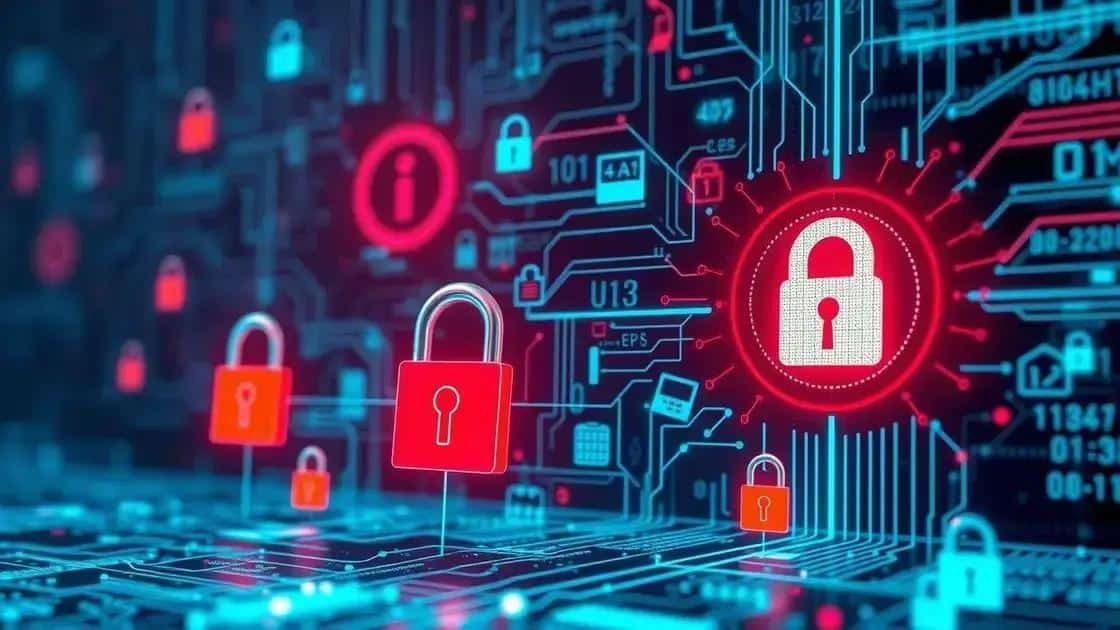Write cybersecurity threats 2025: what to expect

To defend against future cyber threats, organizations must implement advanced security measures, conduct regular audits, and provide employee training while prioritizing incident response plans to enhance overall cybersecurity.
Write cybersecurity threats 2025 to understand the rapidly evolving landscape is crucial for everyone. As technology keeps advancing, so too do the strategies used by cybercriminals. How prepared are you to face these challenges?
Emerging ransomware trends
As technology evolves, ransomware attacks become more sophisticated. It’s crucial to stay informed about these changes. This section will explore the emerging trends in ransomware that you should be aware of to protect your data.
Increased Use of Ransomware-as-a-Service (RaaS)
One notable trend is the rise of Ransomware-as-a-Service. This model allows less experienced cybercriminals to launch attacks easily. By renting malware from developers, they can execute complex attacks without technical skills. The accessibility of these services has led to a significant increase in ransomware incidents.
Targeting Critical Infrastructure
Another trend is the targeting of critical infrastructure. Hackers are now focusing on essential services like healthcare, power grids, and water supplies. The goal is to cause chaos and force organizations to pay quickly to restore services.
- Government agencies have been common targets, exposing vulnerabilities in national security.
- Private companies are increasingly held hostage, impacting operations and finances.
- These attacks often cause severe disruptions and put citizens at risk.
Furthermore, using advanced tactics like double extortion is becoming common. In this method, attackers not only encrypt data but also threaten to release it publicly if their demands are not met. This adds pressure on victims to comply quickly.
It’s also important to note that attackers are using social engineering techniques. They often manipulate individuals to click on malicious links or download infected files. This increases the likelihood of successful attacks.
Preparation and Response
To combat these evolving threats, organizations must prioritize cybersecurity training and awareness. Regularly educating employees about the dangers of ransomware can significantly reduce risks.
Moreover, maintaining regular backups of important data is essential. This ensures that, in case of an attack, organizations can quickly recover without paying the ransom.
Establishing incident response plans is crucial. Being prepared to act swiftly can mitigate the impact of a ransomware attack.
Phishing attacks in evolving landscapes
Phishing attacks are becoming more sophisticated and widespread. Understanding the evolving landscape of these attacks is essential for everyone. Cybercriminals are constantly developing new tactics to trick unsuspecting individuals into revealing sensitive information.
Changes in Phishing Techniques
Traditional phishing emails often contained obvious signs of fraud, but now attackers are using more legitimate appearances. They may spoof trusted brands, making it difficult to identify a scam. As a result, many people fall victim to these traps.
- Emails are now designed to look official, using logos and similar formatting.
- Links may lead to very realistic-looking websites, further deceiving the victim.
- Social media platforms are also targets, with attackers sending direct messages to trick users.
Additionally, there has been an increase in spear phishing, which targets specific individuals or organizations. This method involves extensive research on the victim to create personalized attacks, making them even harder to detect.
Emerging Phishing Scams
New scams continue to emerge as technology changes. For instance, smishing, or SMS phishing, is becoming increasingly popular. Attackers send text messages that appear to come from reputable sources, convincing people to click on malicious links.
Moreover, voice phishing, also known as vishing, is on the rise. Attackers use phone calls to impersonate trusted entities, often creating a sense of urgency that prompts the victim to act quickly. This can lead to serious security breaches.
As phishing attacks evolve, so do the methods to mitigate them. Organizations need to invest in strong cybersecurity training for employees. Teaching them to recognize red flags can prevent many attacks.
Regularly updating security protocols and software is also crucial. Ensuring that systems are protected against the latest phishing tactics can significantly reduce risks.
The role of artificial intelligence in cybersecurity

The role of artificial intelligence in cybersecurity is becoming increasingly vital. As cyber threats grow more complex, AI offers innovative solutions to enhance security. By analyzing vast amounts of data, AI can help detect anomalies and respond to threats in real time.
Automated Threat Detection
One key advantage of using AI in cybersecurity is automated threat detection. With machine learning algorithms, AI systems can identify patterns that may indicate a security breach. This allows organizations to respond quickly to potential threats.
- AI can analyze user behavior to spot unusual activities.
- It can flag suspicious emails or malicious links faster than human analysts.
- Automated systems reduce the time needed to respond to incidents.
Moreover, AI tools can continuously learn and adapt. As they process more data, their ability to identify new threats improves. This means organizations can stay ahead of emerging cyber risks.
Improving Incident Response
Another important aspect is how AI improves incident response. AI technologies can streamline investigations and automate repetitive tasks. This frees up cybersecurity professionals to focus on more complex issues. With AI, responses can become quicker and more efficient.
For instance, AI can assist in analyzing security logs to identify the source of an attack. It can also help prioritize alerts based on the severity of potential threats. This ensures that the most critical issues get immediate attention.
Additionally, AI can facilitate better communication during an incident. By providing insights and recommendations, it helps teams coordinate and act effectively. This is crucial in minimizing the impact of security breaches.
Cybersecurity for remote work environments
Cybersecurity for remote work environments has become a top priority for many organizations. With more people working from home, protecting sensitive data is critical. Remote work brings unique challenges that require effective strategies to ensure safety.
Understanding the Risks
First, it’s essential to understand the risks associated with remote work. Cybercriminals often target home networks, which may not have the same security measures as corporate environments. This increases the chances of data breaches and unauthorized access.
- Phishing attacks are more common, often using email to trick employees into providing sensitive information.
- Insecure Wi-Fi networks can expose corporate data to hackers.
- Employee devices may lack proper security software, increasing vulnerabilities.
These risks highlight the need for better security practices in remote settings.
Implementing Security Measures
To combat these challenges, organizations must implement robust cybersecurity measures. This includes using virtual private networks (VPNs) to encrypt internet connections. VPNs help protect data from prying eyes and secure communication between employees and the company.
Additionally, employing two-factor authentication can provide an extra layer of security. This requires users to verify their identity using a second method, making it harder for unauthorized users to gain access.
Regular security training is also vital. Equipping employees with knowledge about potential threats can significantly reduce risks. Conducting periodic training sessions helps ensure everyone knows how to recognize phishing attempts and other malicious activities.
Finalizing strong password policies ensures that employees create unique passwords and change them regularly. It is important to avoid using the same password across multiple accounts.
Key defenses against future cyber threats
Key defenses against future cyber threats are essential for protecting sensitive information. As technology evolves, so do the tactics used by cybercriminals. Organizations must stay ahead of these threats to safeguard their data and systems.
Implementing Advanced Security Solutions
The first step in defending against cyber threats is implementing advanced security solutions. This includes firewalls, intrusion detection systems, and antivirus software. These tools help monitor and protect networks from unauthorized access.
- Next-generation firewalls analyze traffic patterns in real time.
- Intrusion detection systems alert security teams of suspicious activities.
- Regular updates to antivirus software protect against new malware.
These solutions create multiple layers of defense, making it harder for attackers to succeed.
Regular Security Audits
Another crucial defense is conducting regular security audits. These audits help identify vulnerabilities within systems. By regularly assessing security measures, organizations can address weaknesses before they are exploited.
Audits should include evaluations of software, network Architecture, and user access controls. Ensuring all devices connected to the network meet security standards is vital.
Additionally, organizations should ensure they have a reliable incident response plan. This plan outlines the steps to take in the event of a cyber attack, helping minimize damage and recovery time.
Employee Training and Awareness
Ultimately, employees play a significant role in defending against cyber threats. Providing regular training sessions helps employees recognize phishing attempts, social engineering tactics, and other cyber threats.
Empowering staff to follow best practices, like using strong passwords and enabling two-factor authentication, significantly reduces overall risk. When everyone understands their role in cybersecurity, the organization creates a stronger defense.
FAQ – Frequently Asked Questions about Cybersecurity for Remote Work
What are the main cybersecurity risks for remote work?
The main risks include phishing attacks, insecure Wi-Fi networks, and unprotected personal devices that can lead to data breaches.
How can I protect my home network from cyber threats?
You can protect your home network by using strong passwords, enabling VPNs, and regularly updating your router firmware.
Why is employee training important in cybersecurity?
Employee training is crucial because it helps employees recognize threats and adopt safe practices, reducing the risk of cyber attacks.
What should be included in an incident response plan?
An incident response plan should outline steps for identifying, responding to, and recovering from a cyber attack, as well as communication protocols.






